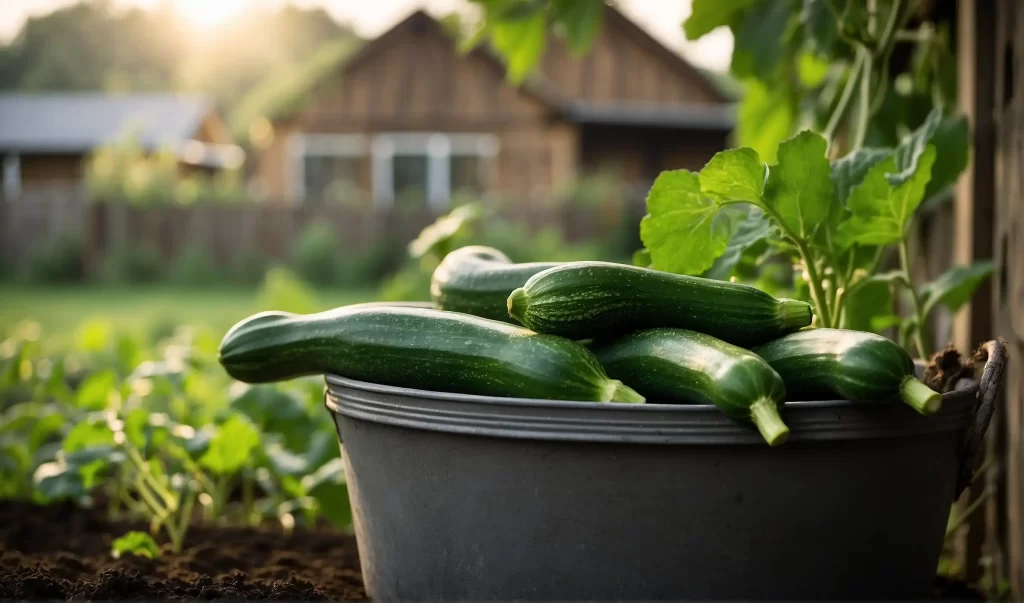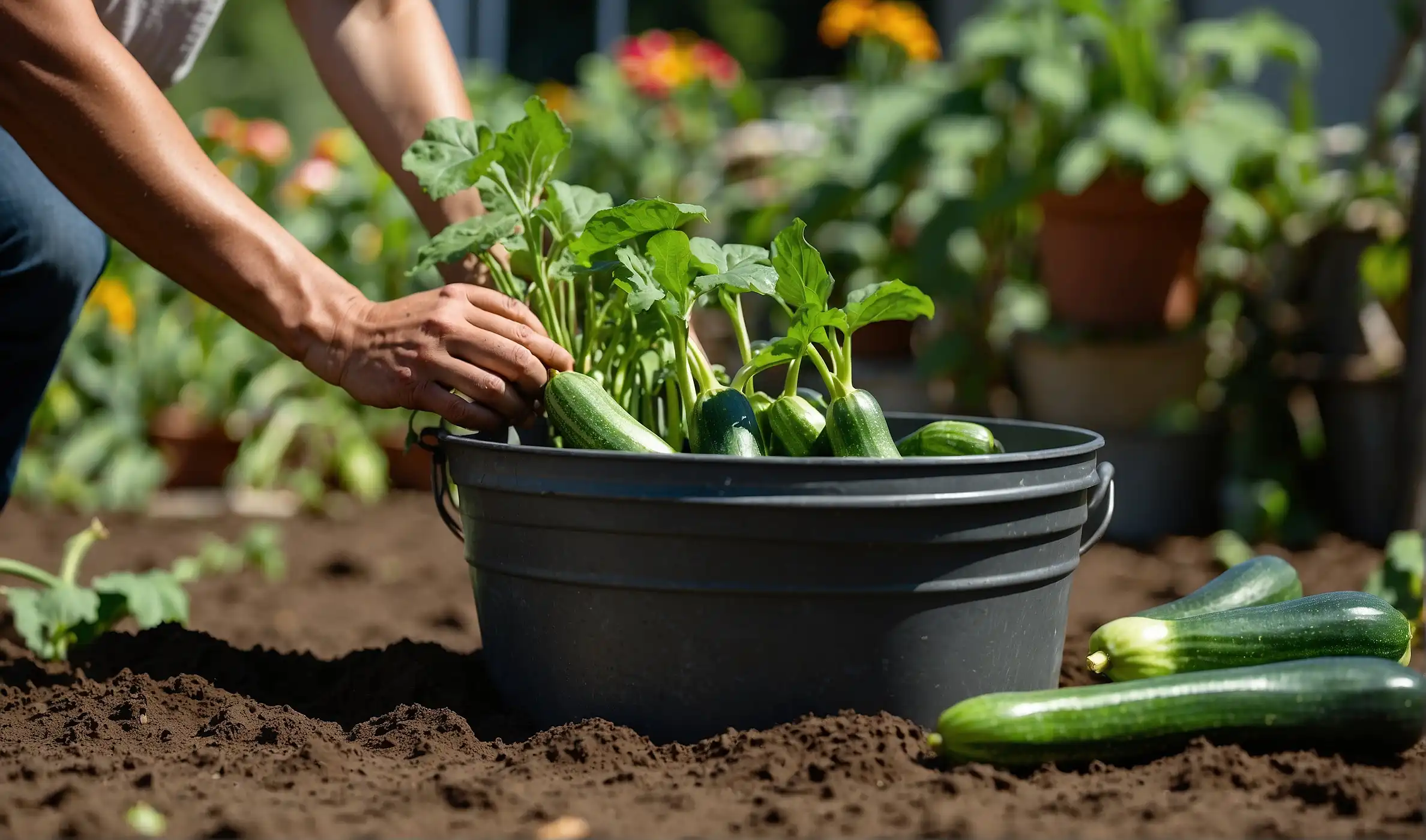Yes, you can grow zucchini in a 5-gallon bucket. The container’s size provides adequate space for one zucchini plant.
Growing vegetables in containers has become increasingly popular, and zucchini is no exception. A 5-gallon bucket is an excellent choice for urban gardeners with limited space or for those who prefer the ease of container gardening. Zucchini plants require ample room to spread out, and a single plant will thrive in a bucket of this size when properly cared for.
With the right soil, sufficient watering, and plenty of sunlight, a zucchini plant can produce an abundant harvest. This method of cultivation not only saves space but also allows for better control over soil quality and moisture levels, leading to a more successful yield.
Growing Zucchini In Small Spaces
Growing zucchini in a 5-gallon bucket is a practical approach for urban gardeners or those with limited outdoor space. The compact nature of containers allows for efficient use of vertical space, making it possible to cultivate healthy zucchini plants on patios, balconies, or small yards. Utilizing a 5-gallon bucket ensures adequate soil volume for the roots to spread, leading to thriving zucchini crops.

The benefits of container gardening include improved control over soil quality, reduced risk of soil-borne diseases, and the ability to adjust plant location for optimal sunlight. Additionally, buckets can be easily maintained, and by managing water and nutrients, gardeners can greatly enhance zucchini production in space-restricted environments.
Choosing The Right Container
Growing zucchini in a 5 gallon bucket is perfectly viable, as long as the container offers enough space for the plants to thrive. A single zucchini plant requires a minimum soil volume of about 5 gallons to grow effectively, making this size bucket an ideal choice. The key is to ensure proper drainage by drilling holes in the bottom of the bucket to prevent waterlogging, which could adversely affect plant health.
| Material | Considerations |
|---|---|
| Plastic | Lightweight, easily portable but ensure it’s food grade to avoid chemicals leaching into soil. |
| Metal | More durable but can conduct heat, potentially warming the soil excessively during hot weather. |
| Fabric | Excellent for aeration and preventing root circling, though may require more frequent watering. |
It is crucial to select food-grade containers if repurposing buckets, as this ensures that no harmful substances will transfer to the plant or its fruits. Zucchini plants also appreciate consistent moisture, so frequent watering may be necessary, especially in warm climates or during the peak of summer.
Also learn: Can Hamsters Have Zucchini
Zucchini Plant Basics
Zucchini plants thrive in well-draining soil enriched with organic matter. Utilizing a 5-gallon bucket allows for control over soil quality, ensuring the plant’s vigorous growth. To achieve the best results, a combination of peat moss, compost, and potting mix is recommended, creating an optimal environment for zucchini roots to expand.
Regular feeding with a balanced fertilizer is essential to cater to the zucchini’s nutritional demands, especially when grown in a confined space. Adequate water retention in the soil mix is critical, but proper drainage must be maintained to prevent root rot.
To Grow Zucchini In a 5 Gallon Bucket
Growing zucchini in a 5-gallon bucket is certainly possible, but the process requires specific conditions to be successful. Key factors include adequate sunlight, consistent watering, and proper fertilization. Zucchini plants thrive with at least 6 to 8 hours of direct sunlight daily. Ensuring the bucket has several drainage holes at the bottom is crucial to avoid waterlogging, which can lead to root rot.
Another important aspect to consider is the quality of soil; a rich, well-draining potting mix is ideal. To promote healthy growth, use a balanced, slow-release fertilizer. The plant will also need ample space to spread, so positioning the bucket in an area where it won’t be cramped is essential. Despite the space limitations of a 5-gallon bucket, optimizing these conditions can lead to a fruitful harvest.
| Factor | Requirement |
|---|---|
| Sunlight | 6-8 hours of direct sunlight daily |
| Watering | Consistent, avoid waterlogging |
| Soil | Rich, well-draining potting mix |
| Fertilization | Use balanced, slow-release fertilizer |
| Spacing | Ensure bucket is placed with room to spread |
Preparing Your Bucket For Zucchini
Growing zucchini in a 5 gallon bucket is both space-efficient and productive. The key to success lies in proper drainage, which ensures the soil is moist yet not waterlogged, promoting healthy root development. To prepare your bucket, begin by drilling holes at the bottom. You should aim for at least four to six holes, each about half an inch in diameter. These will serve as the primary drainage points.
For additional drainage and to prevent soil from escaping through the holes, consider lining the bottom with a layer of gravel or non-woven geotextile fabric. This will create a barrier while still allowing water to drain effectively. Besides, the correct soil mix is crucial; opt for a well-draining potting mix enriched with compost to support your zucchini’s growth. Ensuring these drainage essentials are in place leads to a robust zucchini plant with a bountiful harvest.
Sowing Zucchini Seeds Properly
Growing zucchini in a 5 gallon bucket is an excellent option for gardeners with limited space. To ensure successful germination, take care with seed spacing. Each zucchini seed should be planted to a depth of about an inch. It’s important to provide ample room for roots to grow, so spacing should be roughly 2 to 3 seeds per bucket. This method allows room for the strongest seedling to thrive, while the others can be thinned out.
The environment within a 5 gallon bucket requires careful monitoring to facilitate the germination process. Proper soil selection and moisture control are pivotal to prevent overcrowding and to encourage healthy growth. Regular watering and ensuring a good drainage system will help maintain an optimal environment for zucchini seeds to sprout effectively.
Caring For Your Zucchini Plant
Zucchini plants thrive with consistent moisture; aim for about an inch of water per week, either from rainfall or manual watering. Use a drip irrigation system or water directly at the base to minimize leaf moisture, which can lead to fungal diseases. Water in the early morning to allow evaporation from the leaves during the day.
Regarding nutrition, zucchini is a heavy feeder. Start with a well-balanced fertilizer when planting, and follow up with a nitrogen-rich fertilizer every 3-4 weeks. Composting can be an effective method to enrich the soil without over-fertilizing. Be aware of the signs of nutrient deficiency—yellow leaves often indicate a need for additional nitrogen.
| Aspect | Care Instructions |
|---|---|
| Watering | 1 inch/week, at the base, early morning |
| Fertilization | Well-balanced at planting, nitrogen-rich every 3-4 weeks, use compost as needed |
Combatting Pests And Diseases
Zucchini plants are vulnerable to a variety of pests and diseases. Common threats include squash vine borers, aphids, powdery mildew, and spider mites. To combat these issues, gardeners can adopt both organic and chemical strategies.
Gardeners seeking organic control should consider methods like hand-picking pests, using insecticidal soap, and applying neem oil. These tactics are eco-friendly and can minimize harm to beneficial insects. Alternatively, chemical solutions involve using specific pesticides designed to counteract the identified pests or diseases. It’s crucial to select the right chemical treatment and follow the application instructions carefully to ensure effectiveness without overuse.
Harvesting And Maintenance Tips
Identifying the perfect time to harvest zucchini can greatly influence the quality of your yield. Generally, zucchini should be picked when they are about 6 to 8 inches long. Waiting too long can result in a bitter taste and a tough texture. Another indicator is the skin of the zucchini; it should be glossy and firm. If the zucchini skin can be pierced easily with your fingernail, it is likely ripe for picking.
After you’ve harvested your zucchini, it’s important to maintain the bucket for future planting. Begin by removing all remaining plant debris and wash the bucket with warm soapy water to eliminate potential pests and diseases. Before storing or reusing the bucket, make sure it is completely dry. Additionally, consider replenishing the soil with compost or a balanced fertilizer to ensure nutrients will be available for the next round of plants.
FAQs: Grow Zucchini In A 5 Gallon Bucket
Is Growing Zucchini In A Bucket Possible?
Yes, you can grow zucchini in a bucket, specifically a 5-gallon one. Ensure proper drainage in the bucket and use a high-quality potting mix for best results.
What Size Bucket For A Single Zucchini Plant?
A single zucchini plant requires a 5-gallon bucket at minimum. This size provides adequate space for root development and nutrient absorption essential for healthy growth.
How Much Sunlight Do Bucket Zucchinis Need?
Zucchini in buckets need full sunlight, meaning at least 6 to 8 hours daily. Place your bucket in a spot that gets consistent, direct sunlight to thrive.
Can I Use Regular Garden Soil In Buckets?
It’s not recommended to use regular garden soil in buckets. Opt for a light, nutrient-rich potting mix that ensures proper drainage and aeration for your zucchini’s roots.
Conclusion about to grow zucchini in a 5 gallon bucket
Absolutely, growing zucchini in a 5 gallon bucket is not only possible, but also quite rewarding. This compact gardening method opens up opportunities for urban gardeners and those with limited space. Just remember: proper drainage, sunlight, and regular watering are key.
Embrace this simple, efficient way to enjoy homegrown zucchini!
On Farm Pioneer, discover how crop rotation benefits zucchini farming, leading to richer soil and better yields season after season.
